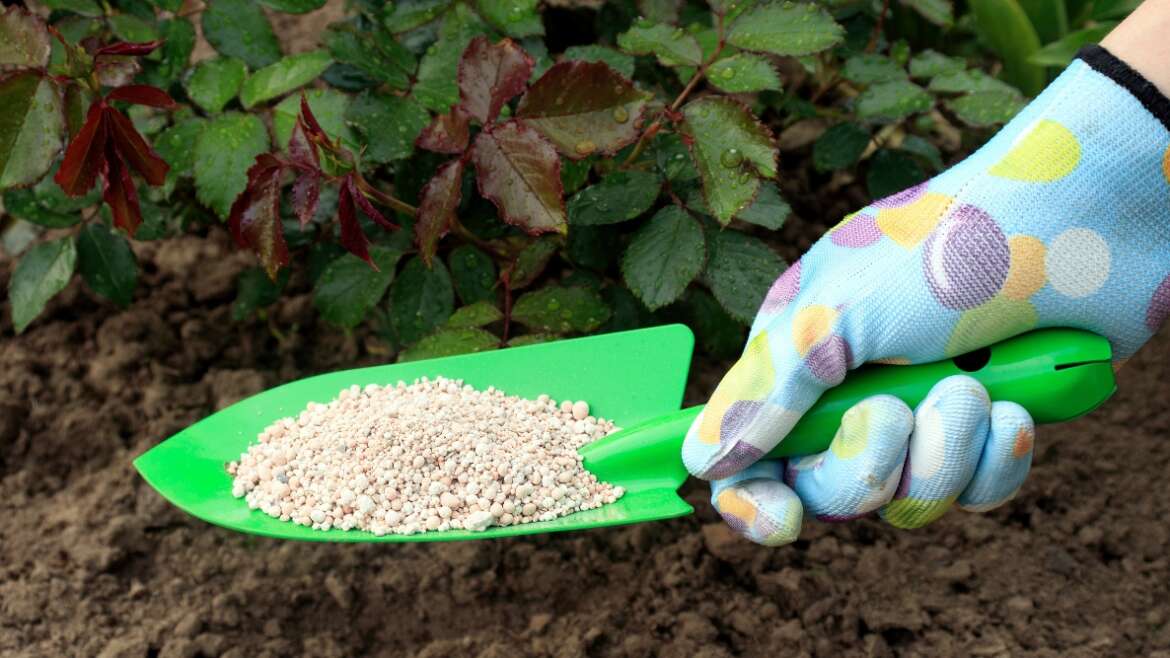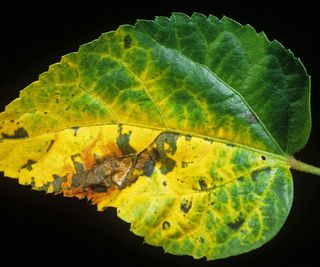If you want a full flush of roses next spring and summer, fall is the time to prepare. Fall rose care is essential to readying your plants for winter and boosting growth next spring. This is even more important for those in cooler climates where frost arrives quickly.
Add these nine fall rose care tasks to your seasonal gardening checklist. Your rose garden will thank you for it.
Slow Down Feeding
Slow down fertilizing in the fall to prevent encouraging tender new growth that might not survive frost.
We all want our roses to continue blooming into fall as long as possible. This may push some gardeners to keep up with feeding before flowers start to fade. Unfortunately, this can end up causing more damage once frost arrives.
Growth slows in the fall, and your roses prepare to rest for winter. Fertilizing at this time, especially with fertilizers high in nitrogen, will encourage the production of new green growth far more vulnerable to cold damage and pest attack.
Those in warmer zones (around zone 8 and above) can continue feeding in early fall but should also stop around six weeks before frost occurs. Avoid high-nitrogen fertilizers, choosing products with higher potassium and phosphorus values to strengthen flowering without encouraging new leaves and stems.
Enjoy your roses’ last fall blooms, but don’t push for more at the expense of plant health over the winter.
Avoid Deadheading
 Let your roses transition naturally in fall by allowing them to form rosehips from their late-season flowers.
Let your roses transition naturally in fall by allowing them to form rosehips from their late-season flowers.
Deadheading is a vital rose task that boosts production and gives you masses of gorgeous flowers to bring indoors. While regular deadheading will increase the number of flowers, allowing your roses to slow down in fall as temperatures drop is important.
Fading flowers are part of a rose’s natural lifecycle. The production of hips signals that the flowering season is ending, allowing your roses to slow growth in fall and settle in for the winter. Without this adjustment, seasonal confusion and a less natural transition into winter may occur.
Avoiding deadheading and leaving rosehips to form doesn’t have to be a negative either. Hips bring great ornamental value to fall gardens and make an excellent tea. Leave them on the plant until the first light frost – an extra chill will boost their sweetness. Don’t wait too long, though, as hard freezes may lead to damage.
Limit Watering
 Water deeply but infrequently to support the rose’s changing growth habits as it enters dormancy.
Water deeply but infrequently to support the rose’s changing growth habits as it enters dormancy.
Newly planted roses appreciate regular moisture to establish strong root systems. As growth kicks off, they also need more water to develop that lush foliage over spring and summer.
Producing lush leaves and intricate flowers requires plenty of resources – one of which is water. You may water more often in summer, especially when temperatures are high, to ensure your roses have everything they need to bloom without stress.
Since more moisture is used when the plant is growing quickly and flowering profusely, it makes sense that less moisture is needed as growth starts to slow down. While you shouldn’t completely forget about your roses, you can adjust your watering routine in the fall to provide water deeply but infrequently.
If your roses have been in the ground for a few seasons, their root systems are likely well-established and happy in their homes. Deep watering will ensure moisture reaches the roots lower down, pushing deeper into the soil and increasing drought tolerance.
Infrequent watering makes up for slower growth and the lack of evaporation that comes with cooler temperatures, avoiding any accidental overwatering before frost sets in.
Thin The Foliage
 In fall, lightly prune roses by thinning the foliage to improve air circulation, reduce disease risk, and prevent wind damage.
In fall, lightly prune roses by thinning the foliage to improve air circulation, reduce disease risk, and prevent wind damage.
With general care changes covered, your next task is the annual fall prune. Many roses benefit from light fall pruning, with some adjustments depending on the conditions in your area and the plant’s performance.
The first step in the fall pruning process is to thin the foliage. Dense leaf growth with limited airflow creates the perfect conditions for disease to settle in, so it’s best to prune offshoots back lightly in the early fall. Later in the season, once the leaves at the base start to die off, you can remove more foliage, leaving the canes bare.
Fewer leaves, especially on the top end of the plant, will also help limit potential wind damage, depending on fall conditions in your area. Top-heavy plants with lots of leaves can get caught by the wind, risking snapped canes and physical damage that increases your risks of pests and diseases.
If you live in a warmer region, you can typically wait until later in the season to thin the leaves – potentially only in early winter.
Shorten The Stems
 Always use clean, sharp tools to prevent disease spread.
Always use clean, sharp tools to prevent disease spread.
In mid to late fall, once you’ve thinned the leaves, it’s time to shorten the stems. This doesn’t need to be a heavy prune. Aim to cut down about one-third of the plant’s height, which will help the stems stay strong in the face of high winds or heavy rain.
At the same time, you can cut back any stems crossing over or interfering with another rose nearby. If canes frequently brush together in high winds, the friction causes wounds that create the perfect conditions for pests and diseases to sneak in.
Before pruning, it’s vital to ensure your tools are sharp and clean. The last thing you want to do now is spread disease from another plant to your roses thanks to dirty shears. Disinfect and sharpen your shears before you head into the garden to make clean and risk-free cuts.
Removed Damaged Leaves And Stems
 Continuously remove damaged stems and leaves throughout the year to bolster rose health.
Continuously remove damaged stems and leaves throughout the year to bolster rose health.
The final step in the pruning process should be done continuously throughout the year – not just in the fall.
Damaged stems and leaves make your roses far more vulnerable to pests and diseases, primed to attack in areas where the plant is weakest. Removing these in the fall improves the plant’s overall health and growth by eliminating diseased or damaged tissues that draw energy away from new leaf and stem production.
Common pests and diseases like black spot and borers are also prevalent. Black spot can overwinter on stems and in the soil to come back in spring, so it’s essential to remove any diseased areas now before they take hold.
Also, watch for other wildlife, like rodents, looking for a place to keep warm over winter.
Clean Up Around The Base
 Remove fallen leaves and stems around your roses to prevent disease, pests, and untidiness.
Remove fallen leaves and stems around your roses to prevent disease, pests, and untidiness.
After trimming, you’ll likely have a lot of plant debris built up around the base of your roses. Even if you haven’t pruned yet, fall is when leaves will start dropping off the stems from the bottom, collecting around the soil.
Removing these old leaves and stems is essential to the fall cleanup routine. Debris provides an ideal home for pests and diseases, either settling in the soil for spring or spreading upwards to the canes. This debris can also attract wildlife and generally makes your rose garden look untidy.
Removal is even more important if any growth you’ve trimmed is diseased. Fungal spores can spread from this debris to healthy plants around your garden, undermining the purpose of pruning in the first place. Don’t put diseased foliage into your compost pile, as the spores may linger and can spread from the compost to the rest of your garden. Throw them in the trash or burn them instead.
Keep the area at the base of your roses clean and clear. This also makes way for the next step – mulch.
Mulch
 Apply a thick layer of organic mulch around your roses to regulate soil temperature and boost soil health.
Apply a thick layer of organic mulch around your roses to regulate soil temperature and boost soil health.
Fall mulching comes with many benefits for your roses.
A thick layer of organic mulch will help regulate temperature, keeping the soil conditions moderate without extreme fluctuations. This is especially important in very cold climates to protect the root system or in very warm climates where getting the roses to settle down for winter can be tough. Pay extra attention to grafted roses, which are more sensitive to winter damage than own-root roses.
Mulch is also a great way to boost soil health over fall and winter in preparation for an explosion of growth in spring. Compost is an ideal fall mulch for roses, enriching the soil and improving structure over time.
Apply a layer of mulch around five inches thick, building it up from the center of the plant. This should last over fall and winter, but you can also top up the mulch as it breaks down.
Cover Climbing Roses
 Secure climbing roses to their support to prevent wind damage in fall.
Secure climbing roses to their support to prevent wind damage in fall.
Care for climbing roses is slightly different in fall. Due to the risk of winds snapping the stems, you must ensure the plant is completely secure before strong fall weather kicks in.
You can trim climbing roses slightly to eliminate damaged or diseased growth, but you don’t need to do any major cutting. The most important concern is that the stems are firmly secured to their support. Add ties to stop any wayward stems from moving, or bunch them together and cover them in burlap for protection.
If you live in a very windy or cold area, you may want to bend the stems down to the ground for protection. Bundle them together and cover them in burlap or straw.
Final Thoughts
Take care of these fall rose tasks to ensure healthy plants next spring. You’ll be rewarded with less disease and pest pressure, reduced potential for winter damage, and beautiful, strong plants ready to bloom again!




